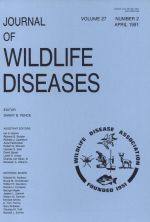Tuberculosis was diagnosed in 10 of 16 otariid seals upon post mortem examination. The species involved were New Zealand fur seals (Arctocephalus forsteri), Australian sea lions (Neophoca cinerea) and an Australian fur seal (Arctocephalus pusillus doriferus). Five seals died, four as a direct result of mycobacterial infection. One seal died of unrelated disease. The remaining 10 animals were subsequently tuberculin tested and then killed and necropsied. Tuberculous lesions were seen in five. Gross pathological changes were most commonly seen in the respiratory system. However, a generalized infection, a case with lesions confined to the liver and draining lymph nodes, and a case with tuberculous meningitis also were seen. Histological lesions were characterized by spindle cell proliferation and necrosis without mineralization or giant cell formation. The mycobacteria isolated was identified as belonging to the Mycobacterium tuberculosis complex but it appeared to be unique. Intradermal tuberculin testing showed promise as a diagnostic aid; however, the results were not statistically significant. Circumstances suggest that the initial infection was present when the seals were captured from the wild.
How to translate text using browser tools
1 April 1991
TUBERCULOSIS IN A CAPTIVE COLONY OF PINNIPEDS
D. Forshaw,
G. R. Phelps

Journal of Wildlife Diseases
Vol. 27 • No. 2
April 1991
Vol. 27 • No. 2
April 1991
captive study
intradermal tuberculin test
Mycobacterium tuberculosis complex
otariid seals
TUBERCULOSIS




